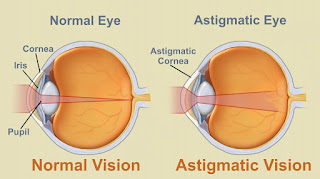We are faced with this question on a regular
basis. Astigmatism might be the most
misunderstood vision problem. Even the
name is challenging to many people, who incorrectly call it
"stigmatism."
In addition to the spherical lens power used to correct nearsightedness or farsightedness, astigmatism requires an additional "cylinder" lens power to correct the difference between the powers of the two principal meridians of the eye.
Astigmatism is a refractive error,
meaning it is not an eye health problem; it simply is a problem with how the
eye focuses light, like nearsightedness & farsightedness.
In an eye with astigmatism, light
fails to come to a single focus on the retina to produce clear vision. Instead,
multiple focus points occur, either in front of or behind the retina (or both). This causes blurry, distorted vision.
When someone has a significant
amount of uncorrected astigmatism, they can expect to experience eye strain and
headaches, especially after reading and other visually-lengthy tasks. Ex:
working on a computer for a long period of time without taking breaks.
Squinting is a very common symptom of uncorrected astigmatism as well.
Squinting is a very common symptom of uncorrected astigmatism as well.
Astigmatism usually is caused by an
irregularly shaped cornea. Instead of
the cornea having a symmetrically round shape (like a basketball), it is shaped
more like a football, with one meridian being significantly more curved than
the meridian perpendicular to it.
(To understand what meridians are,
think of the front of the eye like the face of a clock. A line connecting the
12 and 6 is one meridian; a line connecting the 3 and 9 is another.)
The steepest and flattest meridians
of an eye with astigmatism are called the principal meridians.
In some cases, astigmatism is caused
by the shape of the lens inside the eye. This type of astigmatism is called
lenticular astigmatism, to differentiate it from the more common corneal
astigmatism.
There are several types of
astigmatism:
- Myopic astigmatism.
One or both principal meridians of the eye are nearsighted. (If both
meridians are nearsighted, they are myopic in differing degree.)
- Hyperopic astigmatism. One or both principal meridians are farsighted. (If
both are farsighted, they are hyperopic in differing degree.)
- Mixed astigmatism.
One prinicipal meridian is nearsighted, and the other is farsighted.
Astigmatism also is classified as
regular or irregular. In regular astigmatism, the principal meridians are 90
degrees apart (perpendicular to each other). In irregular astigmatism, the
principal meridians are not perpendicular. Most astigmatism is regular corneal
astigmatism, which gives the eye a football shape.
Irregular astigmatism can result
from an eye injury that has caused scarring on the cornea, from certain types
of eye surgery or from keratoconus, a disease that causes a gradual thinning of
the cornea.
Astigmatism is detected during a
routine eye exam with the same instruments and techniques used for the
detection of nearsightedness and farsightedness. Dr. Bogart can estimate your amount of
astigmatism by shining a light into your eye while manually introducing a
series of lenses between the light and your eye. This astigmatism test is
called retinoscopy.
Though many eye doctors continue to
perform retinoscopy, this manual procedure has been replaced or supplemented in
many eye care practices with automated instruments that provide a faster
preliminary test for astigmatism and other refractive errors. At Carolina Eye Center, we have several
machines that can test for astigmatism.
Whether retinoscopy or an automated
refraction is performed as a preliminary astigmatism test, Dr. Bogart will
refine the preliminary finding with a manual refraction prior to issuing your eye
glasses or contact lens prescription.
Astigmatism,
like nearsightedness and farsightedness, usually can be corrected with eye
glasses, contact lenses, or even refractive surgery. In the past, there was no technology to
correct astigmatism with LASIK & PRK procedures. Today, we have advanced technology that can
correct most types of this condition!
In addition to the spherical lens power used to correct nearsightedness or farsightedness, astigmatism requires an additional "cylinder" lens power to correct the difference between the powers of the two principal meridians of the eye.
If you wear soft toric contact
lenses for astigmatism correction, your contact lens prescription will likewise
include a sphere power, cylinder power and axis designation.
Gas permeable lenses can also
correct astigmatism. Because these lenses are rigid and optically replace the
cornea as the refracting surface of the eye, a cylinder power and axis may or
may not be needed, depending on the type and severity of astigmatism correction
required.
To find out what your options are to correct your astigmatism, give our office a call: 803-794-0000, and schedule your exam with Dr. Walt Bogart today!


Comments
Post a Comment